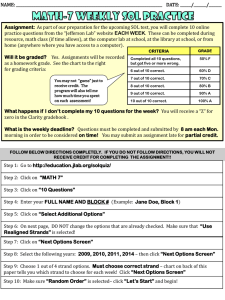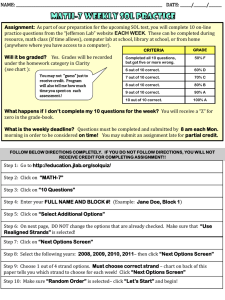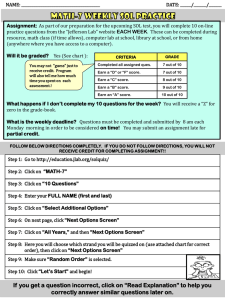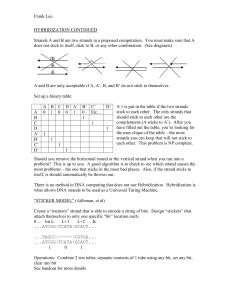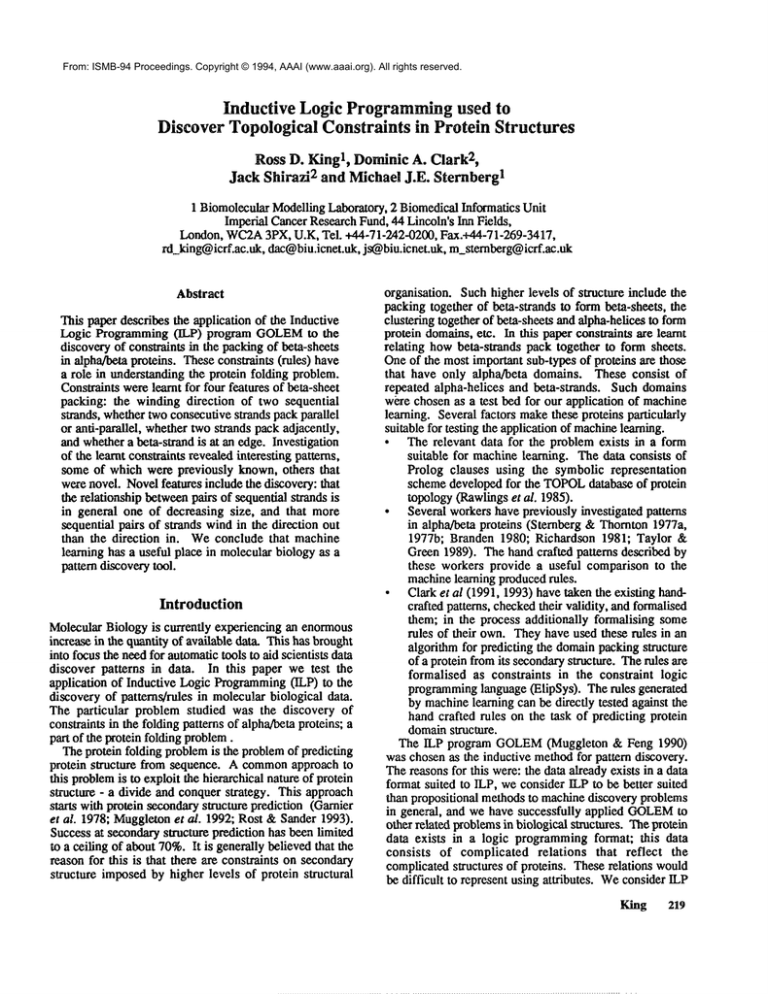
From: ISMB-94 Proceedings. Copyright © 1994, AAAI (www.aaai.org). All rights reserved.
Inductive Logic Programmingused to
Discover Topological Constraints in Protein Structures
Ross D. King1, 2,
Dominic A. Clark
2
1
Jack Shirazi and Michael J.E. Sternberg
1 BiomolecularModellingLaboratory,2 BiomedicalInformaticsUnit
Imperial CancerResearchFund,44 Lincoln’sInn Fields,
London,WC2A
3PX, U.K, Tel. +44-71-242-0200,Fax.+44-71-269-3417,
rd ldng@icrf.ac.uk,dac@biu.icnet.uk,js@biu.icnet.uk,m_sternberg@icrf.ac.uk
Abstract
This paper describesthe application of the Inductive
Logic Programming 0LP) program GOLEM
to the
discoveryof constraints in the packingof beta-sheets
in alpha/betaproteins. Theseconstraints (rules) have
a role in understandingthe protein folding problem.
Constraintswerelearnt for four features of beta-sheet
packing: the windingdirection of two sequential
strands, whethertwoconsecutivestrands packparallel
or anti-parallel, whethertwo strands packadjacently,
andwhethera beta-strandis at an edge. Investigation
of the learnt constraints revealedinteresting patterns,
someof which were previously known,others that
werenovel. Novelfeatures include the discovery:that
the relationshipbetweenpairs of sequentialstrands is
in general one of decreasing size, and that more
sequential pairs of strands windin the direction out
than the direction in. Weconclude that machine
learning has a useful place in molecularbiology as a
pattern discoverytool.
Introduction
MolecularBiologyis currently experiencingan enormous
increasein the quantityof availabled~t~: This has brought
into focusthe needfor automatictools to aid scientists data
discover patterns in data. In this paper we test the
application of Inductive Logic Programming
0LP)to the
discoveryof patterns/rules in molecularbiological data.
The particular problem studied was the discovery of
constraintsin the foldingpatterns of alpha/betaproteins; a
part of the protein foldingproblem.
Theprotein folding problemis the problemof predicting
protein structure from sequence. A common
approach to
this problemis to exploit the hierarchicalnatureof protein
structure - a divide and conquerstrategy. This approach
starts with protein secondarystructure prediction (Gamier
et al. 1978; Muggletonet al. 1992; Rust & Sander1993).
Successat secondarystructure prediction has beenlimited
to a ceiling of about70%.It is generallybelievedthat the
reasonfor this is that there are constraints on secondary
structure imposedby higher levels of protein structural
organisation. Suchhigher levels of structure include the
packingtogether of beta-strands to formbeta-sheets, the
clustering togetherof beta-sheetsandalpha-helicesto form
protein domains,etc. In this paper constraints are learnt
relating howbeta-strands pack together to form sheets.
Oneof the mostimportantsub-typesof proteins are those
that have only alpha/beta domains. These consist of
repeated alpha-helices and beta-strands. Suchdomains
w~rechosenas a test bed for our application of machine
learning. Severalfactors makethese proteins particularly
suitable for testing the applicationof machine
learning.
¯ Therelevant data for the problemexists in a form
suitable for machinelearning. The data consists of
Prolog clauses using the symbolic representation
schemedevelopedfor the TOPOL
database of protein
topology(Rawlingset al. 1985).
¯ Severalworkershavepreviouslyinvestigated patterns
in alpha/beta proteins (Sternberg & Thornton1977a,
1977b; Branden 1980; Richardson 1981; Taylor &
Green1989). The handcrafted patterns described by
these workers provide a useful comparisonto the
machinelearning producedrules.
¯ Clark et al (1991, 1993)havetakenthe existing handcrafted patterns, checkedtheir validity, andformalised
them; in the process additionally formalising some
rules of their own.Theyhave used these rules in an
algorithmfor predicting the domainpackingstructure
of a protein fromits secondarystructure. Therules are
formalised as constraints in the constraint logic
programming
language(ElipSys). The rules generated
by machinelearning can be directly tested against the
hand crafted rules on the task of predicting protein
domainstructure.
The ILP program GOLEM
(Muggleton & Feng 1990)
waschosenas the inductive methodfor pattern discovery.
Thereasonsfor this were:the data alreadyexists in a data
format suited to ILP, weconsider ILP to be better suited
than propositional methodsto machinediscoveryproblems
in general, and wehave successfully applied GOLEM
to
other related problemsin biologicalstructures. Theprotein
data exists in a logic programmingformat; this data
consists of complicated relations that reflect the
complicatedstructures of proteins. Theserelations would
be difficult to representusing attributes. WeconsiderILP
King
219
programs more suitable for machine discovery than
attribute based ones because: they can better express
background knowledge(there is commonlya great deal of
relevant background knowledge in scientific discovery
problems), and they can learn a more general set of
concepts (it is difficult to represent manyscientific
concepts using attributes).
GOLEM
has previously been
applied to the prediction of protein secondary structure
0VIuggletonet al. 1992), the design of drugs to fit into the
active sites of proteins (King et al. 1992), and machine
discovery (King et al., 1994).
Methods
Database of Proteins
The proteins chosen were of class alpha/beta. The original
data comes from the PIPS deductive database (Shirazi
Clark 1993), which is in turn derived from the IDITIS
relational database (marketed by Oxford Molecular and
developed by Gardner and Thornton extending the work of
(Islam & Stemberg 1989)). The PAPAINdatabase is
deductive database implementedin the constraint logicprogramminglanguage ElipSys. The selection of proteins
was carried out using the non-homologousset of protein
folds described by (Orengo et al. 1993) Brookhavenrelease
61. All protein domainswere chosen that are in the IDITIS
database and the Orengosub-classes (80 Str) alpha/beta:
Doubly Wound, alpha/beta:
One Doubly Wound, and
Alpha/beta: Two Doubly Wound. Domains in the Orengo
sub-class alpha/beta Tim Barrel were excluded because of
problems in the designation of barrels in the IDITIS
database. The data was further filtered by removal of
homologousbeta-sheets, so that for each protein only nonhomologoussheets were included. The gave the following
set of proteins:
1CSE, 2FCR, 2TRX, 3ADK, 3CHY,
3PGM,- 4DFR, 4FXN, 5CPA, 5P21, 1GD1, 1PHH, 2TS1,
3GRS, 6LDH, 8ADH, 8CAT, 1RHD, 2LIV, 2YHX, 3GBP
(S. Typhimurium: Orengo used E. Coli), 3PGK, 4PFK.
Fromthis set the following proteins were randomlychosen
as a test set (7 from 23): 3ADK,3CHY, 4FXN, 1GD1,
8ADH,1RHD,3GBP. The remaining proteins were used
as a training set.
Data Representation
The ILP program GOLEMwas used in this study.
GOLEM
takes as input: positive examples, negative
examples, and background knowledgedescribed as Prolog
ground clauses. The Prolog representation
used in
GOLEM
is a modified version of that used in TOPOL
OT,awlings et al. 1985). It drawson the experience of the
representations used to represent protein sequences in
(Muggleton et al. 1992; King et al., 1994) and drugs in
(King et al. 1992). In the experiments a basic set of
background facts was used. Fromthese facts, a numberof
different predicates describing alpha/beta proteins were
220
ISMB-94
learnt. The basic idea is that the background knowledge
consists of facts that could be assumedto be knownafter a
successful secondary structure prediction (Fig. 2). From
this information it is possible to predict the next level of
protein structure, howthe secondary structure elements
pack together. The learnt descriptive predicates describing
alpha/beta proteins will aid in this prediction of protein
structure. For each descriptive predicate, rules were learnt
for it and its negation: e.g. predicate foo(A), and not
foo(A). The intention was to produce rules that had high
accuracy and statistical significance. It was not intended
that rules would necessarily cover all the examples, i.e.
discriminate between examples with and without the foo
predicate. Thereasons for this are: the rules are intendedto
be input into a constraint-satisfaction algorithm, and the
rules are intended to be understandableto protein chemists.
The following descriptive predicates were learnt:
edge(P,S).
In protein P strand S is positioned at the edgeof a sheet.
parallel(P,Sl ~2 ).
In protein P consecutivestrands S I and $2 are parallel.
adj(P ~l,S2 ).
In protein P strands S 1 and $2 are adjacent in a sheet.
in(P ,51~2).
In protein P strand S1 is closer to the edge than strand $2.
printed
The following structural background knowledge was used
(P is a proteinid.).
seql(P,S,L).
In P strand S has length L.
con_helix(P ,S1~S2,H ).
In P strands S 1 and $2 are joined by H helices.
con_length(P ,S1 ,S2,R).
In P strands S 1 and $2 are joined by R residues.
c on_to_helix l ( P,S1,S 2,N).
In P betweenS 1 and $2 the First helix has id. N.
c on_to_helix2( P ,S1,S 2,N).
In P betweenS 1 and $2 the last helix has id. N.
con_tochainl (P,S1,S2 M).
In P betweenS1 and $2 the fast coil has id. N.
con to chain2(P,S1,S2,N).
In P betweenS 1 and $2 the last coil has id. N.
The following hydrophobic background knowledge was
used (In P,E, meansin protein P, sheet E; hydro, energy is
hydrophobic energy).
th(P,E,SdtO.
In P,E, strand S has a total hydro, energyof Ht.
avh(P ,E,S,Ha).
In P,E strand S has an average hydro, energy of Ha.
rth(P,E,S,Htr).
In P,E strand S has a rank of total hydro, energyof Htr.
r hy( P,E,~,nar).
In P,E strand S has a rank of average hydro, energy of Htr.
W Internal prediction
V
Edgeprediction
Figure 1. Schematic d la~-am showingedge and not edge predictions for the protein Dihydrofolate reductase: circles are
alpha-helices, triangles beta-sheets.
Eachpiece of secondary structure (strand, helix, turn, and
loop) has a numberthat allows its position to be related in
sequenceto the other structures using arithmetic relational
predicates. Typed arithmetical information is also given
for the various predicates above. Typingprohibits spurious
roles e.g. equaling the rank of total hydrophobicenergy to
the numberof helices separating it to the next strand (it is
an inductive bias).
pairsl (P,Sl ~2 ).
In protein P strand S2 follows strand S 1.
pairs2(P,SI ,S2 ).
In protein P strand S 1 precedes strand $2.
(pairsl and pairs2 have opposite GOLEM
determinations)
pred(A,B).
BisA+ 1.
succ( A,B).
AisA- 1.
(pred and succ have opposite GOLEM
determinations)
lt(A,B).
A is less than B.
For each of the data sets there were 9263 background
facts in the training d~ta and 8047 backgroundfacts in the
test data. The training data for the predicate edge consisted
of 71 positive examples and 91 negative examples.
Henceforththe construct [X : Y] is used as an abbreviation
for "X positive examples and Y negative examples". The
test data consisted of [27 : 42] examples.The training data
for the predicate parallel consisted of [66 : 46] examples.
The test data consisted of [39 : 11] examples. The training
data for the predicate adjacency consisted of [127 : 786]
examples. The test data consisted of [58 : 360] examples.
The training data for the strand direction predicate
consisted of [36 : 60] examples. The test data consisted of
[18 : 26] examples.
Results
Rules for the Edge of a Sheet
Three rules were learnt for edge, and one rule for not_edge.
These rules covered in the training examplesall but [14 :
35] examplesand all but [6 : 14] test examples. Accuracy
is defined as the numberof correctly predicted examples
divided by the total numberof predictions. Coverageis the
numberof correctly predicted examplesdivided by the total
numberof possible correct predictions. The coverage and
accuracygiven is that for each rule taken in isolation.
Rule edgel:
[Train cov. 0A65,ace 0.891: Test coy. 0A82,ace. 0.765]
edge(A,B) :- rth(A,C,B,rthO).
Rule edge2:
[Train coy. 0.310, ace. 0.880:. Test cov. 0.148, ace. 0.500]
edge(A/B) :- pairs2(A,C,B), pairs2(A,D,C), seql(A,B,13).
Rule edge3:
[Train coy. 0.197, ace. 1.000: Test coy. 0.296, ace. 1.000]
edge(A;B):- seql(A,8,12).
Rule noLedgel:
[Train coy. 0.550, ace. 0.909: Test coy. 0.4681, ace. 0.815]
not_edge(A,B)
pred(F,E), pred(H,G), pred(l,H), rhy(A,D,B,E
rth(A,D,B,G), con to chain2(A,B,C).
The ordering of strands in sheets by their hydrophobic
energy was first stressed by Steinberg and Thornton
(Steinberg & Thornton 1977a) who noted that "the most
hydrophobicstrand is buried and the remaining strands are
arranged in decreasing hydrophobicity outwards in both
directions". Rule edgel, states that the strand of lowest
King
221
rank hydrophobicityin a sheet is at an edge, this is implied
by the Sternberg and Thornton statement. Sternberg and
Thorntonfurther noted that total hydrophobicenergy was a
better measure than average hydrophobic energy for
predicting the ordering of strands. This is still true, and is
reflected in GOLEM?s
choice of total hydrophobic energy.
The best way found by GOLEMto characterise
the
remaining edge strands was to examinestrand length, rules
edge2 and edge3. Strand length is closely related to total
hydrophobic energy. Twoconditions of rule not_edgel
deal with hydrophobic energy: that the rank of total
hydrophobicenergy of an edge is at least two, and it does
not have the lowest rank of average hydrophobic energy.
These are consistent with the current understanding of
protein structure. For a strand to be internal it should have
a reasonable amountof not too diffuse hydrophobicenergy.
The other condition in not.edgel, that the following strand
should be in the samesheet, is moredifficult to understand
It maybe that the connecting to a strand in another sheet
disrupts hydrophobic ordering because of the packing of
the edgeto the other sheet.
strand B should not have the lowest rank of average
hydrophobicenergy. The other conditions of parallel2 are:
that sheets B and C are connected by at least 1 helix, and
that the length of B is greater or equal to C. This final
conditionis interesting, it suggeststhat there is a relatively
greater chance of being anti-parallel when the second
strand is of greater length than the f’u’st. Suchstrands are
relatively rare (46 examples) comparedto pairs where the
first strand if of greater length (71 examples). It
interesting to note howthe relation A >= B is represented
by the Prolog program induced by GOLEM.
The relation
is not given in the backgroundknowledge,where there is
only A > B; the relation is therefore expressed by A + 1 >
B. Rule not-parallell is basically the negation of rules
Parallel I and Parallel2, its most importantcondition being
that no helix separates the strands.
Rules for Strand Orientation
Tworules were learnt for parallel, and one rule for not
parallel. Theserules covered in the training examplesall
but [7 : 8] examples and [8 : 2] test examples. The
coverage and accuracy of each rule is that for each rule
taken in isolation.
Ruleadj 1:
[Train coy. 0.441, ace. 0.849: Test coy. 0.345, ace. 0.833]
Ruleparallel 1:
[Train coy. 0.636, ace. 0.977: Test coy. 0.564, acc. 1.000]
parallel(A,B,C)
pred(F,E), rhy(A,D,B
con__helix(A,B ,C,G), pred(H,G
Rule adj2:
[Train cov. 0.354, ace. 0.818: Test cov. 0.349, ace. 0.870]
adj(A,B,C)
con_helix(A,B,C,D), pairs2(A,E,B), rth(A,F,B,G),
pred(H,G),seql(A,CJ), seql(A,B,l), succ(J,K),
Rule parallel2:
[Train coy. 0.500, ace. 0.868: Test coy. 0.410, ace. 0.833]
parallel(A,B,C)
con_length(A,B,C,D), con helix(A,B,C,F ), succ(D
pred(G,F), rth( A,H,C,l), l~ed(J,l ), seql( A,C,K
seql( A,B,L), succ(L,M), lt( K
Rulenot_adj 1:
[Train coy. 0.396, ace. 0.978: Test coy. 0.386, ace. 0.979]
notadj(A,B,C)
th(A,D,B,E), succ(E,F), succ(F,G), rhy(A,H,C,l),
rhy(A,D,B,1),succ(J
J(, ), lt(l,K), pairsl (A,B,L
pairsl (A,LAt), pred(N,C),pred(Ofil), lt(M,O).
Rulenot__parallell:
[Train coy. 0.696, ace. 0.865: Test coy. 0.727, ace. 0.667]
not..parallel(A,B,C)
pred(D21), pred(E,D), con_helix(A~,C,hiO).
Rule not_adj2:
[Train coy. 0.313, ace. 0.984: Test coy. 0.397, ace. 0.960]
not_adj(A,B,C)
avh(A,D,B,E),pairs2( A JF,B), avh(A,D,F,G
pairs2(AJt,C),It(B J-l), pred(l,F), pred(J
pairsl (A,B,K),rth(A~/K d~l ), pred(Nd~l
Rule parallell has two conditions. Thet’n’st condition, is
that the strands are connectedby at least 1 helix. This is
consistent with current understandingof protein structure;
if there wasno helix, it is unlikely that connectionbetween
the strands wouldbe long enoughto allow the protein chain
to loop back to the start of the first strand. The second
condition, that strand B should not have the lowest rank of
average hydrophobic energy in its sheet, suggests that
parallel strands are more hydrophobic than anti-parallel
strands. This idea is supported by the work of (Lifson
Sander 1979). The first condition of parallel2 is, that
222 ISMB--94
Rules for Strand Adjacency
Tworules were learnt for adjacent, and three rules for not
adjacent. Theserules covered in the training examplesall
but [60 : 234] examplesand [18 : 89] test examples.
aaj( A,B,C)
con_length(AM,C,D ), succ(D,E), seql(A,C,F),
succ(F,G),seql(A,B,H),pred(l,H), lt(l,G), succ(tt,J),
pred(KJF),It(K,1).
Rule not_adj3:
[Train cov. 0.350, ace. 0.984: Test coy. 0.419, ace. 0.968]
notadj(A,13,C)
pairsl (A,C,D), con_length(A,C,D;E), succ(E~),
th(A,G,BJ-I), succ(H,l), succ(l,J),
con to chainl(A,C,K), pred(L,K), pred(M,L),
succ(BJV), pred(O,C),pred(e,o), It(NtiS).
Themostimportantfeature that wasfoundin the rules
for predicting adjacency, is that the two strands must
followin sequence(Richardson1981). This illustrates the
importanceof short range interactions in sheet formation.
Note, however,that in the context of packingprediction,
short range meansa far greater distance than it wouldin
predicting secondary structure. The reason that
sequentiallyadjacent strands are likely to packadjacently
in space is due to themhaving a far greater chance of
interacting duringthe folding process. Ruleadjl has the
interesting conditionthat the stands mustdiffer in lengthby
less than 2 residues. This is consistent with the current
understandingof protein structure, as adjacent strands
should be about the same length, so that they can form
hydrogenbonds. Notehowthis condition is representedin
1GD1 -A
7
GOLEM,
it is built up from the greater-than relation (<)
and the successorrelation (+1) in the followingway:((((A
+ 1) + 1) > B) and (((B + 1) + 1) > A))). Thediscovery
such a complicawA
relation betweentwo length illustrates
the power of the ILP methodology. A conventional
attribute based learning system would not have great
difficulty in learningthis concept.
The rules for predicting that two strands will not be
adjacent in a sheet are the mostcomplicatedfoundin this
study. This reflects the larger numberof examplesof nonadjacencycomparedto adjacency,and the needfor highly
accurate rules. Themost important condition preventing
strands becoming
adjacentis that the strands are separated
by a sufficient distance. Thisis the reverseof conditionof
the mostimportantconditionfor strands being adjacenL
7
6
6
5
4
4
3
3
2
2
1
1
0
5
6 7 2 1 8 9 11
10
0
16 17 19 15 12 14 13
18
Figure 2. Predictions of windingdirection. TheY-axis is the rank of total hydrophobicenergy. TheX-axis is the
sequential numberof strand, i.e. swandno. x is the nth in sequence.Arrowsshowthe prediction of windingdirection;
dotted arrowsare incorrect predictions. In sheet 1GD1-C,
swands17 and18 havethe sameposition in the sheet - causing
twopredictionerrors.
Rules for Strand Direction
Onerule werelearnt for in, andonerule for out (not in).
Theserules coveredin the training examplesall but [10 :
11] examplesand [2 : 3] test examples.Thecoverageand
accuracyof eachrule is that for eachrule takenin isolation.
Ruleinl:
[Traincoy. 0.500,ace. 0.818:Testcov. 0.556,ace. 0.833]
in(A,B,C)
conto chain!(A,B,D), con_iength(A,B
,C,E
succ(E,F),rth(A,G,B,H),rth(A,G,CJ),pred(JJ),
lt(H,l).
Ruleoutl:
[Traincoy. 0.750, ace. 0.849:Testcoy. 0.808, ace. 0.777]
out(A,B,C
)
con_.to_chain2(A,B,D),
succ(D,E),succ(E,F),
rth(A,G,C,H),rth(A,G,BJ), succ(I J), It(Hi).
In rule inl the mostimportantconditionis that the rank
total hydrophobicenergy of C should be 2 ranks greater
than B. This is consistent with the analysis of Sternberg
and Thornton (Sternberg & Thornton 1977a); who
proposed that strands are ordered in terms of their
hydrophobicities,with the mosthydrophobic
strands in the
centre. In rule outl the mostimportantconditionis that the
total hydrophobicenergyof B greater than or equal to C.
This is almost the reverse of rule inl, although it is
interesting that the conditionfor movingin is morestrict
than moving
out, i.e. it is easier to windouLToillustrate
the applicationof the rules learnt by GOLEM
the results of
applying rules inl and outl to glyceraldehyde
dehydrogenase
are shownin Fig. 2.
It is importantto notethat there are moreconnectionsin
the direction towardsthe edgethan there are awayfromthe
edge(significantat 1%level); this is illustrated in Fig.
This figure also neatly illustrates whythe discrimination
betweenrules inl andoutl in terms of difference in total
hydrophobic energy is placed where it is. Wherethe
difference in ranks is twoor greater, then there are more
King 223
¯
examples of in compoxcdto out: where the difference is
zero or less there arc more examplesof out: the case is
ambiguouswhere the difference is 1.
Somerules were found to be identical, e.g. the rule:
"the least hydrophobic strand is on the edge of the
sheet (using total hydropathies)’, is identical
meaningwith rule edgel. This rule originated in the
work of Sternberg and Thornton (Sternberg
Thornton 1977a).
Other rules are closely related but are somewhatmore
general, e.g. parallel beta-alpha-beta connections
should contain at least 10 residues in the coil (Taylor
& Green 1989).
However, some of the proposed rules for nucleotide
binding domainsdid not genexalise to all alpha/beta
proteins. For example, Branden (1980) proposed the
rule: that the initial strand in sequenceis not an edge
sheet. This can be translated into Prolog as:
[Train coy. 0.127, acc. 0.600 ." Test 0.185, 0.833]
not_edge(A,S):- lt(1,S).
This rule has rather a low accuracy and coverage
compared to the rules found by GOLEM.
Other proposed rules could not have been found
because of the limitation of the representation used.
For example, Taylor and Green (Taylor & Green 1989)
proposed that unconserved strands are at the edge.
This rule could not have found as the concept of
conservation of sequence is not represented in the
background knowledge; it relates to the rate of
mutation across homologous proteins. Similarly,
Richardson (1981) proposed that there is only one
change in winding direction in a sheet. Such a rule
could not have been found because the concept of
change in winding direction is second order compared
to strand direction.
Discussion
¯
Winding Direction
A number of the rules found by GOLEM
are thought to be
consequences of the fact that beta-sheets in alpha-beta
proteins are more likely to start windingfrom the centre
out, than from the edge in. This tendency has been hinted
at in the literature (Richardson 1981), but the logical
consequences of it have not been fully appreciated. The
consequenceswere discovered by consideration of the rules
generated by GOLEM.
One consequence is that because
proteins are roughly globular in shape, the relationship
between pairs of sequential strands is one of decreasing
size, i.e. the first strand is likely to be larger than the
second. This constraint may be usefully applied back to
secondary structure prediction. Windingfrom the centre
out also explains whythere are morepairs of strands in the
direction out than in (Fig. 3). It takes a relatively large
change in rank total hydrophobic energy between two
sequential sheets to changethe direction of winding.
¯
¯
Comparison with Hand Crafted Rules
A number of hand crafted rules have been proposed for
constraints in the folding of beta strands in alpha/beta
proteins, see discussion in Clark et al. (1991). It
interesting to compare these rules with those found by
GOLEM:
20"
18"
16"
14"
1210-
0
-6
-5
-4
-3
[] out
-2
-1
0
1
2
3
4
5
6
[] in
Figure 3. The difference in rank of total hydrophobic energy by winding direction. In means that the strand winds
towards the centre of the sheet: out meansthat strand winds towards the edge of the sheet. The X-axis is the difference
in rank of total hydrophobic energy. The Y-axis is the numberof strand pairs with the difference in rank of total
hydrophobic energy.
224
ISMB-94
EfipSys Rules
Theexisting hand-produced
rules concernedrelating to the
secondarystructure packingof alpha/beta proteins have
been gatheredtogether by Clark et al (1991, 1993). These
rules were formalisedand translated into logic programs
andused as part of an overall structural packingprogram.
This program inputs one or more protein secondary
structure assignmentsandoutputs a predicted packingfor
the protein. Currently the rules and program are
implemented
in the parallel constraint logic programming
language ElipSys. The success of these hand-produced
rules at predicting protein packingpatterns is currently
beingevaluatedby a systematicprediction of the database.
The rules discovered by GOLEM
are being wanslawxlinto
ElipSys.It is intendedto directly comparethe success of
these rules with the hand-produced
ones on the systematic
predictionof the database.
Machine Learning as a Tool for Molecular Biology
In this paper, machinelearning is viewedas a tool to aid
scientists in the discovery of patterns in data from
molecularbiology. It is considered to be an alternative
method to: examining data "by eye" (perhaps using
sophisticated visualisation software), or the use of
statistical methods. Wesee the process of applying
machinelearning to a scientific problemas an interactive
cycle betweenthe problemformulationby the scientist and
application of a machinelearning program.
¯ Thescientist first identifies the problem
of interest.
¯ Aformaldata representationis createdthat is intended
to capturethe importantfeatures of the problem.
¯ Theactual data is thentranslatedinto this formalism
to
producea modelof the problem.
¯ This data is input into the machinelearning systemand
rules generated.
¯ Thescientist then examinesthe rules to gleamany
regularities and patterns in the data that are of
scientific interesL
¯ If this cycle is successful the newly discovered
regularities can be used to form a better data
representationandthe cycle repeated.
Conclusions
This paper tests the applicationof ILPto the discoveryof
patterns in data in molecularbiology. ILP was used to
discover constraints in the packing of beta-sheets in
alpha/betaproteins. Constraints(rules) werelearnt for four
features of beta-sheetpacking:the windingdirection of two
sequential strands (two rules found), whether two
sequentialstrandspackparallel or anti-parallel (three rules
found), whethertwo strands packadjacently (five rules
found), andwhethera beta-strandis at an edge(four rules
found). Investigation of the rules revealed interesting
patterns, someof whichwerepreviouslyknown,others are
that are novel. Novelfeatures include two previously
unrecognised
consequences
of the bias of windingdirection
to start fromthe centre: that the relationshipbetween
pairs
of sequential strands is in generalone of decreasingsize,
i.e. the first strandis likelyto be larger thanthe second;and
that moresequential pairs of strands windin the direction
out thanin.
Acknowledgements
Wewould like to thank Chris Rawlings and Steve
Gardner(Oxford Molecular) for makingID1TISraw data
available, and Steve Muggletonfor supplying GOLEM.
References
Branden,C. (1980). Q. Rev. Biophys13: 317-338.
Clark, D. A., Rawlings,CJ., Shirazi, J., Veron,A. and
Reeve, M. (1993). Protein topology prediction through
parallel constraint logic programming.
In Proceedingsof
the First International Conferenceon Intelligent Systems
for MolecularBiology, AAAI/MIT
Press, MenloPark.
Clark, D. A., Shirazi, J. andRawlings,C.J. (1991).Protein
topologyprediction through conslraint-based search and
the evaluationof topologicalfoldingrules. Prot. Engng,4:
751-760.
Gamier, J., Osguthorpe, D.J. and Robson, B. (1978).
Analysis of the accuracy and implications of simple
methodsfor predicting the secondarystructure of globular
proteins. J. Mol.Biol. 120: 97-120.
Islam, S. A. and Sternberg M.J.E. (1989). A relational
databaseof proteinstructuresdesignedfor flexible enquires
aboutconformation.Prot. Engng,2(6): 431-442.
King, R. D., Muggleton,S., Lewis, R. and Sternberg,
Mj.E.(1992). Drugdesignby machinelearning:, the use
inductive logic programmingto modelthe structttreactivity relationships of trimethoprimanaloguesbindingto
dihydrofolate reductase. Proc. Natl. Acad. Sci. USA89:
11322-11326.
King, R.D., Clark, D.A., Shirazi, J., Sternberg, MJ.E.
(1994) Discoveryof protein structural constraints in
deductivedatabase using inductive logic programming.
In
MachineIntelligence 14 eds. D. Michie,S. Muggleton,K.
Furakawa.OxfordUniversityPress. Oxford.(in press)
Lifson, S. and Sander,C. (1979).Antiparallel andparallel
beta-strands differ in aminoacid residue preferences.
Nature282. 109-110.
Muggieton,S. and FengC. (1990). Efficient induction
logic programs.In Proceedingsof the First Conferenceon
AlgorithmicLearningTheory, Tokyo,Jpn. Soc. Artificial
Intelligence.
Muggleton,S., King, R.D. and Sternberg, MJ.E.(1992).
Protein secondarystructure prediction using logic-based
machinelearning. Protein Engng.5(7): 647-657.
King 225
Orengo, C. A., Flores, T.P., Taylor, W.R.and Thornton,
J.M. (1993). Identification and classification of protein fold
families. Prot. Engng. 6(5): 485-500.
Rawlings, C. J. E., Taylor, W.R., Nyakairu, J. Fox, J. and
Stemberg, M.J.E. (1985). TOPOL.J. Idol. Graphics 3(4):
151-157.
Richardson, J. S. (1981). The anatomy and taxonomy
protein structure. Advancesin Protein Chemistry 34: 167339.
Rost, B. and Sander C. (1993). Prediction of Protein
Secondary Structure at Better than 70%Accuracy. J. Mol.
Biol. 232: 584-599.
Schulz, G. E. and Schirmer R.H. (1978). Principles of
Protein Structure. Springex-Verlag.
Shirazi, J. and Clark, D.A. (1993). CombiningDatabases
and constraints in protein structural analysis. Technical
report ESPRITproject 6708 "Applause".
Sternberg, M. J. E. and Thornton J.M, (1977a). On the
conformation of proteins: hydrophobicordering of strands
in beta-pleated sheets. I. Mol. Biol. 115: 1-17.
Sternberg, M. J. E. and Thornton J.M. (1977b). On the
conformationof proteins: towards the prediction of strand
arrangementsin beta-pleated sheets. J. M. Biol, 113: 401418.
Taylor, W. R. and Green N.M. (1989). The predicted
secondary structure of the nucleotide-binding sites of six
cation-transporting ATPasesleads to a probable tertiary
fold. EuropeanJournal of Biochemistry 179:241-248.
226
ISMB-94


